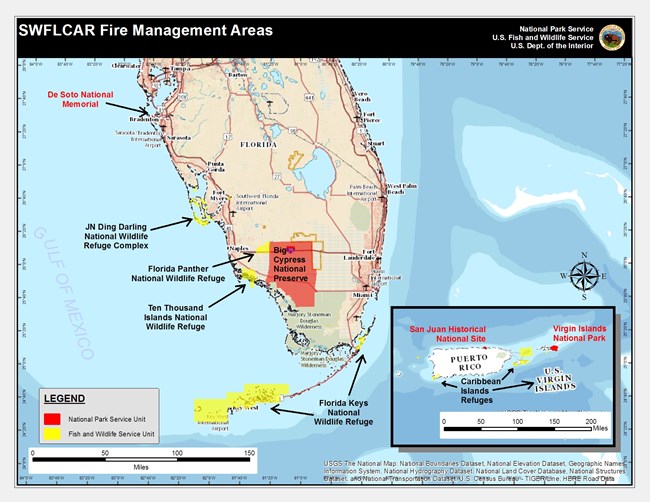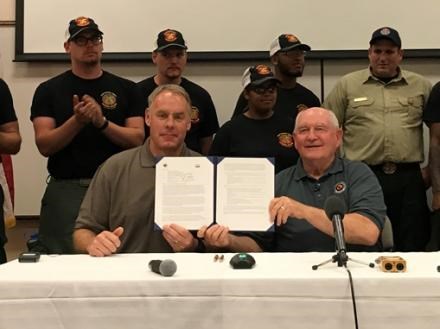Last updated: June 21, 2017
Article
Interagency Collaboration in Protecting Communities and Managing Public Lands

Photo courtesy Mindy Wright, Big Cypress National Preserve
Interagency Collaboration Yields Benefits to Wildland Fire and Aviation
With the signing of a June 2017 joint memo (picture left, courtesy of USDA), Department of Interior (DOI) Secretary Ryan Zinke and Department of Agriculture (USDA) Secretary Sonny Perdue formally directed Wildland Fire leadership throughout the two agencies to seek opportunities to improve and increase collaboration and cooperation. The Secretaries need look no further than Big Cypress National Preserve (BICY) of the National Park Service (NPS) and Florida Panther (Panther) National Wildlife Refuge (NWR) of the US Fish & Wildlife Service (FWS) to find a successful example of just what that can look like. BICY and Panther are partners in the interagency Southwest Florida and Caribbean Wildland Fire and Aviation Program, or SWFLCAR (pronounced “Swiffle Car”).
In 2013, as a response to declining budgets, BICY and Panther leadership examined their respective fire programs’ future target organizations. The programs with similar missions and organizations had already worked together for a number of years. After successfully co-managing a large wildfire, leadership on the preserve and refuge agreed collaboration would improve both programs. Less than a week before the 33,000 acre Mud Lake Complex began in May 2015, a co-funded NPS/FWS Assistant Fire Management Officer entered on duty and the programs were officially integrated.
BICY is the headquarters for the NPS Southeast Region’s wildland fire and aviation program responsible for the Southwest Florida Fire Management Zone. Panther is the headquarters for USFWS Region 4 District 6. The joint SWFLCAR program is responsible for wildland fire and aviation related duties of approximately 858,630 acres on NPS and FWS units in Southwest Florida, the Florida Keys, and Puerto Rico.
Thanks to the creation of SWFLCAR, partners receive increased support, especially in wildland urban interface (WUI) areas. In a typical year, SWFLCAR provides support to units in their combined areas of responsibility, as well as federal partners at Merritt Island NWR, Loxahatchee NWR, Rookery Bay National Estuarine Research Reserve, and Everglades National Park. The program also aids neighboring Bureau of Indian Affairs programs on the nearby Seminole Tribe of Florida and Miccosukee Tribe of Indians of Florida reservations. In addition to federal partners, SWFLCAR’s merger greatly benefits state and local partners at Fakahatchee Strand State Park, Picayune Strand State Forest, Collier-Seminole State Park, the Sanibel-Captiva Conservation Foundation and the town of Sanibel.
To overcome merger challenges, BICY and Panther leadership developed an agreement and strategies for contributing funding and sharing resources. A co-funded assistant FMO position was created, a new organizational chart was developed, and staff and responsibilities were divided appropriately.
Although the merger increased the complexity of each program, the level of customer service and support the program is now able to offer throughout their joint area of responsibility is far greater. The creation of SWFLCAR improved operational efficiency by taking advantage of the firefighting infrastructure and assets that were already in place separately. Integrating the separate organizations into one program reduced staffing levels (total FTE), increased amount of available equipment (specialized and non), improved response time and capabilities, and provided a huge boost to morale.
SWFLCAR staffs two zones and a helibase. The partnership allows for more flexibility and opportunity for staff. Staffing during severity and shortages is easier, and they are able to provide more opportunities for details and training.
Interstate 75 (I-75, aka Alligator Alley) connects the South Florida coasts and runs through BICY and along Panther. Response time to incidents that could impact the major interstate has decreased. Two other major thoroughfares run through the area: US-41 and State Route 29. Overall time spent driving has also decreased. (Driving on the local roads is one of the biggest hazards facing SWFLCAR staff.)
The public and wildlife have also benefitted from the merger. The program has boosted their effort to burn 80,000-125,000 acres per year by managing wildfires and conducting prescribed fires. The strategies of both BICY and Panther allow for fire to be managed so that it can naturally roam the landscape so long as it does not pose a threat to firefighter and public safety, or endanger property or impact values-at-risk. This reduces the risk of future catastrophic wildfire by returning fire to the landscape every three to five years, which aids in removing the buildup of hazardous fuels. This is a win for nature enthusiasts and sportsmen who are allowed to hunt in the preserve. As prescribed fire is used more frequently, vegetation burns and ash falls to the ground and replenishes nutrients. Exposed insects and seeds become popular targets for smaller animals and insects. Deer, the primary food source of the endangered Florida panther, quickly return to feed on tender, nutritious new growth.
In the program’s short two-year history, SWFLCAR has managed 86 wildfires (combined 103,721 acres), completed 56 prescribed fires (combined 92,361 acres) and 22 mechanical treatments (combined 287 acres).
An extended drought affected South Florida in 2017. After an April and May in which the local water table stayed over two feet below average, the area experienced repeated red-flag days and multiple starts, both human-caused and lightning-ignited. SWFLCAR’s 2017 wildfire season began earlier than usual with the 7,500+ acre Lee Williams Road Fire in nearby Picayune Strand State Forest, close to the western border of BICY and southern edge of Panther.
The Lee Williams Road Fire followed the southern edge of I-75, impacting travel and commerce, and traveled west to Naples, burning multiple homes and causing the evacuation of thousands of residents. SWFLCAR assisted on the fire.
The program experienced three major fires within their boundaries totaling nearly 50,000 combined acres, that either required requesting a national incident management team (IMT) or relying on IMTs onsite to respond and manage.
The Parliament Fire, believed to be human-caused, was a 26,000+ acre wildfire on the preserve. Due to the need for logistical support, a Type 3 Incident Management Team (IMT) was mobilized to manage the fire. Local resources filled most training positions from Incident Commander to Division Supervisors.
The Cowbell Fire was the second large wildfire of SWFLCAR’s season (within boundaries). The lightning-ignited fire grew to 22,000 acres and required a Type-2 (later a Type-1) IMT due to the fire’s proximity to private homes, private inholdings and I-75. The Southern Area Interagency Gold Team (Type-2) first took over the Cowbell. As the fire grew and threats increased, the Southern Area Interagency Blue Team (Type-1) relieved the Gold Team.
During the Blue Team’s management of the Cowbell and Parliament Fires, the Mile Marker 87 Fire began just north of I-75 on Panther. Resources were pulled from the Cowbell and Initial Attack Divisions to respond to yet another significant human-caused wildfire. Due to the fire’s close proximity to I-75, multiple aircraft were dispatched to provide immediate aviation support. Ground crews supported by wildland fire engines and suppression-capable swamp buggies conducted tactical burnouts late into the night to remove additional fuels in front of the main fire and stop it’s encroachment upon the highway and to keep it from spreading further west toward Naples.
After command was transferred to a Type-4 IMT, resources also assisted on the 30,000 acre Dragonfly Fire, which occurred just off I-75 on the Seminole Tribe of Florida’s reservation. The fire shut down the interstate for approximately six hours on Memorial Day. Supporting efforts from multiple federal, state and local partners helped stop the fire’s spread toward Alligator Alley and mitigate smoke impacts along the highway, which created a huge safety hazard for travelers on the holiday and affected local, regional and national commerce.
91 consecutive days after delegating authority to the first IMT, transfer of command from the last IMT back to SWFLCAR took place after three days of record-breaking rainfall in early June. As the event ushered in the end to their 2017 spring fire season, SWFLCAR leadership immediately began sending personnel out on details, training assignments, and some on well-deserved time off. Meanwhile, due to the successful interagency partnership, staffing is covered and Southwest Florida is still in good hands.
For general information about Big Cypress National Preserve, visit http://www.nps.gov/bicy or call the preserve Visitor Center at (239) 695-1201.

Photo courtesy of USDA
